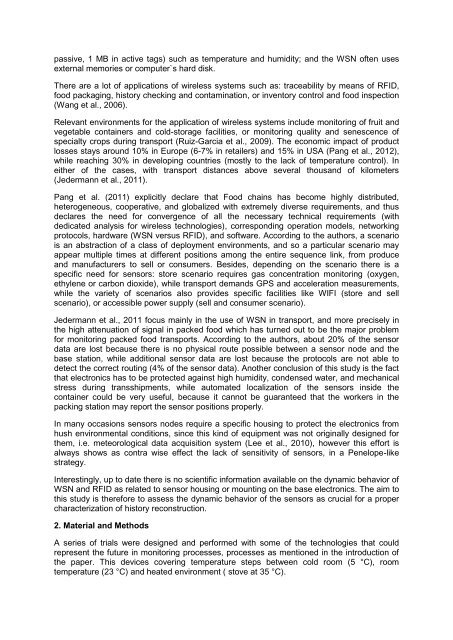ORAL - International Conference of Agricultural Engineering
ORAL - International Conference of Agricultural Engineering
ORAL - International Conference of Agricultural Engineering
Create successful ePaper yourself
Turn your PDF publications into a flip-book with our unique Google optimized e-Paper software.
passive, 1 MB in active tags) such as temperature and humidity; and the WSN <strong>of</strong>ten usesexternal memories or computer`s hard disk.There are a lot <strong>of</strong> applications <strong>of</strong> wireless systems such as: traceability by means <strong>of</strong> RFID,food packaging, history checking and contamination, or inventory control and food inspection(Wang et al., 2006).Relevant environments for the application <strong>of</strong> wireless systems include monitoring <strong>of</strong> fruit andvegetable containers and cold-storage facilities, or monitoring quality and senescence <strong>of</strong>specialty crops during transport (Ruiz-Garcia et al., 2009). The economic impact <strong>of</strong> productlosses stays around 10% in Europe (6-7% in retailers) and 15% in USA (Pang et al., 2012),while reaching 30% in developing countries (mostly to the lack <strong>of</strong> temperature control). Ineither <strong>of</strong> the cases, with transport distances above several thousand <strong>of</strong> kilometers(Jedermann et al., 2011).Pang et al. (2011) explicitly declare that Food chains has become highly distributed,heterogeneous, cooperative, and globalized with extremely diverse requirements, and thusdeclares the need for convergence <strong>of</strong> all the necessary technical requirements (withdedicated analysis for wireless technologies), corresponding operation models, networkingprotocols, hardware (WSN versus RFID), and s<strong>of</strong>tware. According to the authors, a scenariois an abstraction <strong>of</strong> a class <strong>of</strong> deployment environments, and so a particular scenario mayappear multiple times at different positions among the entire sequence link, from produceand manufacturers to sell or consumers. Besides, depending on the scenario there is aspecific need for sensors: store scenario requires gas concentration monitoring (oxygen,ethylene or carbon dioxide), while transport demands GPS and acceleration measurements,while the variety <strong>of</strong> scenarios also provides specific facilities like WIFI (store and sellscenario), or accessible power supply (sell and consumer scenario).Jedermann et al., 2011 focus mainly in the use <strong>of</strong> WSN in transport, and more precisely inthe high attenuation <strong>of</strong> signal in packed food which has turned out to be the major problemfor monitoring packed food transports. According to the authors, about 20% <strong>of</strong> the sensordata are lost because there is no physical route possible between a sensor node and thebase station, while additional sensor data are lost because the protocols are not able todetect the correct routing (4% <strong>of</strong> the sensor data). Another conclusion <strong>of</strong> this study is the factthat electronics has to be protected against high humidity, condensed water, and mechanicalstress during transshipments, while automated localization <strong>of</strong> the sensors inside thecontainer could be very useful, because it cannot be guaranteed that the workers in thepacking station may report the sensor positions properly.In many occasions sensors nodes require a specific housing to protect the electronics fromhush environmental conditions, since this kind <strong>of</strong> equipment was not originally designed forthem, i.e. meteorological data acquisition system (Lee et al., 2010), however this effort isalways shows as contra wise effect the lack <strong>of</strong> sensitivity <strong>of</strong> sensors, in a Penelope-likestrategy.Interestingly, up to date there is no scientific information available on the dynamic behavior <strong>of</strong>WSN and RFID as related to sensor housing or mounting on the base electronics. The aim tothis study is therefore to assess the dynamic behavior <strong>of</strong> the sensors as crucial for a propercharacterization <strong>of</strong> history reconstruction.2. Material and MethodsA series <strong>of</strong> trials were designed and performed with some <strong>of</strong> the technologies that couldrepresent the future in monitoring processes, processes as mentioned in the introduction <strong>of</strong>the paper. This devices covering temperature steps between cold room (5 °C), roomtemperature (23 °C) and heated environment ( stove at 35 °C).
















